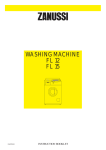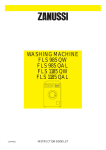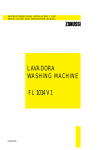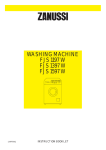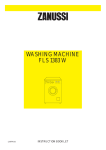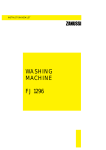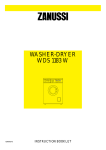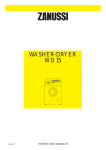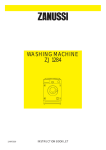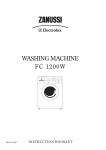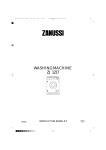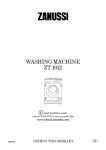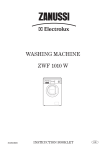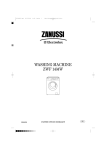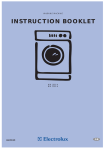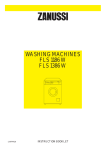Download Zanussi FLS 1084 Owner's Manual
Transcript
WASHING MACHINE FLS 1084 Temp Temp. Whites Fast coloureds Non-fast coloureds Synthetics Mixed fabrics Wool 124976350 A B 95º C 60º D 40º J 50º K 40º L Delicates Quick wash Worn once Rinses Spin 40º M 40º F 30º N G P H Q R INSTRUCTION BOOKLET i Your New Washing Machine Your new washing machine meets all modern needs for effective treatment of laundry with low water, energy and detergent consumption. ■ ■ ■ Automatic cooling of the wash water to 60°C before draining, with the 95°C programme, prevents distortion of plastic pipes in the domestic water system due to the high temperature of the water. The special wool programme with its new delicate wash system treats your woollen with extreme gentleness. The anti-unbalance device ensures that the washing machine remains stable when spinning. In the interest of the environment ■ ■ ■ Ecological hints To save water and energy and help protect the environment, we recommend that you follow these hints: ■ Adjust the quantity of detergent according to the hardness of your water supply, the amount of laundry and the degree of soiling. ■ Select a “quick” programme for lightly soiled laundry. ■ A programme without prewash is sufficient for normally soiled laundry. ■ Materials marked with the symbol are recyclable. Check with your local Council or Environmental Health Office to see if there are facilities in your area for re-cycling this appliance. When the appliance is to be scrapped, cut off the power supply cable and make the door lock device unusable to prevent young children from being trapped inside. Help to keep your country tidy - use authorised disposal sites for your old appliance. How do we help to protect the environment? We use recycled paper! 2 Important Safety Information It is most important that this instruction book should be retained with the appliance for future reference. Should the appliance be sold or transferred to another owner, or should you move house and leave the appliance, always ensure that the book is supplied with the appliance in order that the new owner can get to know the functioning of the appliance and the relevant warnings. These warnings have been provided in the interest of safety. You MUST read them carefully before installing or using the appliance. Istallation ■ ■ ■ ■ ■ ■ ■ Use This appliance is heavy. Care should be taken when moving it. It is dangerous to alter the specifications or attempt to modify this product in any way. All packing and transit bolts must be removed before use. Serious damage can occur to the product and to property if this is not adhered to. See relevant section in instructions. Any plumbing work required to install this appliance should be carried out by a qualified plumber or competent person. Any electrical work required to install this appliance should be carried out by a qualified electrician or competent person. Care must be taken to ensure that the appliance does not stand on the electrical supply cable. If the machine is situated on a carpeted floor, please adjust the feet in order to allow air to circulate freely. ■ ■ ■ ■ ■ ■ Child Safety ■ ■ ■ ■ ■ ■ This appliance is designed to be operated by adults. Children should not be allowed to tamper with the controls or play with the product. Pets and children have been known to climb into washing machines. Please check your drum before use. The glass door becomes very hot during the washing cycle. Keep children away from the vicinity of the appliance whilst it is in operation. Keep all packaging well away for children. Keep all detergents in a safe place out of children’s reach. ■ ■ ■ ■ 3 Always unplug the appliance and turn off the water supply after use. Do not overload the appliance. See relevant section in the instruction book. Only wash fabrics which are designed to be machine washed. If in doubt, consult the care label on the clothes. Before washing, ensure that all pockets are empty and buttons and zips are fastened. Avoid washing frayed or torn articles and treat stains such as paint, ink, rust, and grass before washing. Underwired bras must NOT be machine washed. Any objects such as coins, safety pins, nails, screws, stones or any other hard, sharp material can cause extensive damage and must not be placed into the machine. Garments which have been in contact with volatile petroleum products should not be machine washed. If volatile cleaning fluids are used, care should be taken to ensure that the fluid is removed from the garment before placing in the machine. Wash small items such as socks, laces, washable belts etc in a washing bag or pillow case as it is possible for such items to slip down between the tub and the inner drum. Only use the advised quantities of fabric softener. Damage to the fabric can ensue if you over-fill. Refer to the manufacturer’s recommendations of quantities. As some duvets and eiderdowns should be washed in large commercial machines because of their bulk, please check with the manufacturer of the item before washing in a domestic machine. Leave the porthole door slightly ajar between washes to preserve the door seal. Under no circumstances should you attempt to repair the machine yourself. Repairs carried out by inexperienced persons may cause injury or serious malfunctioning. Contact your local Zanussi Service Force Centre. Always insist on genuine Zanussi spare parts. Contents For the User For the Installer Your New Washing Machine Important Safety Information Description of the Appliance Door locked light Detergent dispenser drawer The Control Panel Operating sequence 2 3 5 5 5 6 Washing 4.5 kg of withe cotton at 95°C Load the laundry Measure out the detergent Measure out the fabric softener Select the required option Select the required programme Start the machine At the end of the programme Washing 2 kg of mixed fabrics at 40°C Load the laundry Measure out the detergent Measure out the fabric softener Select the required option Select the required programme Start the machine At the end of the programme Washing Hints 7-10 7 7 7 7 7 8 8 8 9 9 9 9 9 10 10 10 Installation Instructions Technical Specifications 21 Unpacking Positioning Water inlet Water drainage Levelling Special conditions In the interest of the environment Electrical connection 22 22 23 23 24 24 24 25 11-12 12 12 12 Which detergent to use?.... And in which form? Use of detergent and additives Wash Care Symbols Washing Programmes Maintenance and Cleaning Descaling After each wash External cleaning Cleaning the dispenser drawer Cleaning the drawer recess Cleaning the filter The dangers of freezing Something Not Working Service and Spare Parts Peace of Mind for Twelve Months 13 14-15 16-17 16 16 16 16 16 17 17 18-19 19 20 Guide to use the Instruction Book The following symbols will be found in the text to guide you throughout the instructions: Safety instructions i Hints and tips Environmental information 4 21 Description of the Appliance 1 Detergent dispenser drawer 2 Programme guide 3 “Options” buttons 4 “Mains-on” light 5 Programme selector dial/ON/OFF switch 6 Door opening handle 7 Filter 8 Adjustable feet 2 3 45 1 6 7 8 Detergent dispenser drawer Prewash Wash Fabric softener C0006 5 The Control Panel Temp. Temp. Whites Fast coloureds Non-fast coloureds Synthetics Mixed fabrics Wool A B C D J K L 95º 60º 40º 50º 40º Delicates Quick wash Worn once Rinses Spin Drain 40º M 40º F 30º N G P H Q R 1 2 3 4 5 1 Programme guide 6 7 5 Extra Rinse button By depressing this button the machine will perform the rinses with high water level. This is recommended for people who are allergic to detergents and in areas where the water is very soft. 2 Half load button Select this button to reduce water consumption on the rinse cycle when washing a smaller load of cottons or linens (maximum load size = 2.25 kg). The machine will perform 3 rinses instead of 4. 6 Mains-on light This light illuminates when the machine starts working and goes out at the end of the programme. 3 RINSE HOLD button Press this button to make the machine stop with water in the drum after the synthetic or delicate wash cycles. This prevents any creasing which may take place if the clothes are left damp in the drum. When it is convenient for you to empty the machine, simply press this button again so that the machine can proceed to drain and short spin, or turn the dial to the drain programme “R”. If this button is not activated, the washing programmes will end with a short spin. Do not press this button for woollens: wool items should be gently spun. 7 Programme selector dial/ON/OFF switch With the programme selector dial you choose the desired washing programme. Turn it clockwise. To start the programme, pull the dial outwards. To switch the machine off, push the dial inwards. Before setting the dial to any position the machine must be switched off by depressing the dial. 4 Spin Speed Reduction button By depressing this button the spin speed will be reduced as follows: - cotton and linen: from 1000 to 500 rpm - synthetics, delicates and wool: from 600 to 400 rpm. 6 Operating Sequence Before the first wash, we recommend that you run a cotton cycle at 60°C, without any laundry in the machine, to remove any manufacturing residue from the drum and tub. Pour 1/2 a measure of detergent into the dispenser drawer and start the machine. WASHING 4.5 KG OF WHITE COTTON AT 95°C Suppose you have 4.5 kg of normally dirty laundry to wash. It is white cotton and is suitable for high temperature washing. 1. Load the laundry Open the door by pulling the catch outward. Place the laundry in the drum, one item at a time, shaking them out as much as possible. Close the door. P0004 2. Measure out the detergent Pull out the dispenser drawer until it stops. Measure out the amount of detergent required and pour it into the main wash compartment . If you wish to carry out the prewash, pour detergent into the appropriate compartment marked . C0005 3. Measure out the fabric softener If required, pour fabric softener into the compartment marked (the amount used must not exceed the “MAX” mark in the drawer). Close the drawer gently. C0004 4. Select the required option(s) Depress HALF LOAD and/or EXTRA RINSE , SPIN REDUCTION button, if required. , 7 5. Select the required programme Turn the programme selector dial clockwise to the required programme. B P0215 6. Start the machine Before starting up the machine check that: ■ the appliance is plugged in ■ the water supply taps are turned on ■ the drain hose is correctly and securely positioned ■ the door and the detergent dispenser drawer are closed. Pull the programme selector dial outwards: the mains-on light will illuminate and the machine starts operating. B P0216 7. At the end of the programme The machine stops automatically and the mains-on light goes out. The door is controlled by a safety device which releases 2 minutes after the end of the programme. Switch the machine off by depressing the programme selector dial. When the programme has finished you are advised to unplug the appliance and turn off the water taps. 8 WASHING 2 KG OF MIXED FABRICS AT 40°C Suppose you have 2 kg of Mixed fabrics to wash. They are rather delicate fabrics and should not be washed at a high temperature. 1. Load the laundry Open the door by pulling the catch outward. Place the laundry in the drum, one item at a time, shaking them out as much as possible. Close the door. P0004 2. Measure out the detergent Pull out the dispenser drawer until it stops. Measure out the amount of detergent required and pour it into the main wash compartment . C0005 3. Measure out the fabric softener If required, pour fabric softener into the compartment marked (the amount used must not exceed the “MAX” mark in the drawer). Close the drawer gently. C0004 4. Select the required option Depress the RINSE HOLD button if required. or SPIN REDUCTION 9 5. Select the required programme Turn the programme selector dial clockwise to the required programme. K P0215S 6. Start the machine Before starting up the machine check that: ■ the appliance is plugged in ■ the water supply taps are turned on ■ the drain hose is correctly and securely positioned ■ the door and the detergent dispenser drawer are closed. Pull the programme selector dial outwards: the mains-on light will illuminate and the machine starts operating. K P0216S 7. At the end of the programme The machine stops automatically and the mains-on light goes out. If you have depressed the rinse hold button , the machine will stop with the water left in the tub, to prevent the fabric from creasing. To drain the water release the same button (the clothes will be gently spun) or select programme “R”. The door is controlled by a safety device which releases 2 minutes after the end of the programme. Switch the machine off by depressing the programme selector dial. When the programme has finished you are advised to unplug the appliance and turn off the water taps. 10 i Washing Hints Do NOT overload the machine. Weigh the laundry the first few times you use the appliance. ■ The average weights of the most common items are listed below as a guide: 1000g = 1 kg ■ Sheet 700-1000 g Pillow case 100-200 g Tablecloth 400-500 g Serviette 50-100 g Tea towel 70-120 g Linen hand towel 100-150 g Towelling hand towel 150-250 g Towelling bath towel 700-1000 g Bath robe 200-300 g Apron 150-200 g ■ ■ ■ ■ ■ ■ ■ ■ ■ ■ ■ ■ ■ ■ 1000-1500 g Man’s shirt ■ ■ Load the laundry loosely alternating large items with small ones. Sort the laundry according to the type of fabric, colour-fastness and how dirty it is. Avoid washing unhemmed or torn items as they may unravel. Before washing, empty all pockets of small objects which may have been left inside (coins, keys, screws etc). as these could damage the drain pump. When washing curtains, remove the hooks. Close poppers and zips and fasten loose buttons. It is essential to wash new coloured items separately when washing for the first time. When washing fabrics requiring different wash temperatures together, always select the lowest temperature. White items should not be washed with coloured items. Very small items (handkerchiefs, ribbons, socks etc) should be washed in a washing bag or a pillow case. Use a good quality detergent suitable for automatic washing machines. Use the correct quantities of detergent. For wool, use gentle detergent only in small quantities. Bleach is very corrosive; it should be used with care and kept out of reach of children. 11 Some stains such as fruit, wine, grass, rust etc. are difficult to remove and should be treated before washing with specific products, which can be found in most household shops. In some cases it may help to soak the stain before washing with a special presoak product or biological detergent. Only wool marked “Pure New Wool - washable, preshrunk” can be washed in the machine using the wool programme; other types of wool should be washed by hand or dry cleaned. If you have used the machine to wash, rinse or spin only non-colour fast garments, there may be dye left in the sump. To ensure any subsequent wash is not contaminated with the dye, select and carry out a rinse and spin programme, without any garments, to ensure that any dye is removed from the sump. Once you have finished using the machine, you are advised to unplug it and turn off the water taps. Which detergent to use?.... «BIG BOX» OR COMPACT Compared to their traditional «Big Box»equivalents, compacts (or concentrates as they are also known) have an improved performance and environmental profile, as well as requiring a smaller dosage level. For most clothes and household textiles, CONVENTIONAL DETERGENTS will give good washing results. Conventional detergents are available in either a biological, such as Ariel, or a non-biological form, such as Fairy, and are particularly suitable for whites. Biological detergents provide improved stain removal, especially at lower temperatures. For coloured clothes and household textiles, you should use COLOUR DETERGENTS, like Ariel Color, which are designed to maintain the original colour of these items, as well as providing excellent cleaning performance. These are all biological detergents. They are particularly suitable for matching and co-ordinated sets of lingerie, bedding or towels. For washing wool and silk, COLOUR DETERGENTS ARE NOT SUITABLE. For wool items, you should use a GENTLE/FINE WASH DETERGENT, such as Dreft, which has been tested and approved by the International Wool Secretariat and carries the ‘Woolmark’. A similar detergent should also be used for silk. To maintain the appearance of your clothes and household textiles and to make them last longer, you should use different types of detergent for different washes, whether for whites, colours or delicates. Although this may require buying two or three different products, you do not need to use any more powder, or liquid, than if you were buying just one. FABRIC CONDITIONERS These are ideal for improving ‘softness’. They also reduce static cling on synthetics and make ironing easier. Fabric Conditioners come in three forms: Liquids (regular or concentrated) which work in the final rinse. Sheets for use in the tumble dryer, and Combined Detergent and Fabric Softener Use of detergent and additives Choosing the Right Detergent Always use a low lather powder or liquid. This is important as too much lather prevents the articles from being properly cleansed and may damage the machine. Use of Powder Detergent The washing powder should be placed in the appropriate compartments in the detergent dispenser drawer before starting the programme. Use of Liquid Detergent And in which form? A liquid detergent can be used in the middle compartment of the dispenser drawer. Start the machine immediately upon placing the liquid in the dispenser drawer. Not only are there different types of detergent, but they are also available in different forms. POWDERS OR LIQUIDS Use of Fabric Conditioners Powders and their liquid equivalent provide similar cleaning properties, although liquids dissolve faster when hand washing and at lower temperature washes. Any liquid additives for softening or dressing the laundry must be poured into the appropriate compartment of the detergent dispenser drawer before starting the programme. The compartment with the symbol is for softeners and dressing agents; never exceed the MAX. Ievel. BIOLOGICAL OR NON-BIOLOGICAL All Biological detergents contain enzymes. Different types of enzymes assist with the removal of protein, starch and fat-based stains, such as blood, egg, chocolate and gravy. However, some people prefer nonbiological detergents which do not contain enzymes. When using super concentrated fabric conditioners, please follow the manufacturer’s instructions carefully. LOW SUDS In a front loading automatic washing machine, you should only use a low suds detergent. The majority of detergents are now low suds products. 12 Wash Care Symbols Wash care labels inside garments recommend how to launder your clothes with the best results. The care labelling code is in line with care labelling used in the rest of Europe. The symbols used make it easy to select the correct programme on your washing machine. WASHING SYMBOL WASH ACTION 95 Normal (Maximum) White Cotton or Linen without Special Finishes 60 Normal (Maximum) Cotton, Linen or Viscose without Special Finishes Colourfast at 60°C. 50 Reduced (Medium) 40 Normal (Maximum) 40 Reduced (Medium) 40 Much Reduced (Minimum) Hand wash only FABRIC Nylon, Polyester/Cotton, Viscose with Special Finishes, Cotton/Acrylic Mix. Cotton, Linen or Viscose Colourfast at 40°C but not 60°C. Acrylics, Acetate, Triacetate, Wool mixes, Polyester/wool blends. Wool, wool mixtures, Silks Do not machine wash BLEACHING Chlorine bleach may be used IRONING Hot iron Cotten, Linen, Viscose Warm iron Polyester mixtures, Wool Cool iron Acrylic, Nylon, Polyester DRY CLEANING P May be dry cleaned. Other letters and/or a bar beneath the circle will indicate the required process to the dry cleaner. TUMBLE DRYING May be tumble dried with high heat setting with low heat setting X A cross through any symbol means «DO NOT» Important Notes For best results, always use the dispenser drawer for dispensing detergents and liquid additives. Once the dispenser has been filled, close it by pushing it in gently. This is particularly important if you are using fabric conditioner to avoid the conditioner entering the machine prematurely. When using liquid detergent and a prewash programme, place the detergent into the correct compartment in the dispenser drawer, after the prewash has finished. 13 Washing Programmes Programmes for cotton and linen Wash programme WHITES WITH PREWASH WHITES WITHOUT PREWASH Degree of soil and type of laundry Programme dial position Description A Prewash at 40 °C Wash at 95 °C 4 rinses Long spin at 1000 rpm 4.5 kg B Wash at 95 °C 4 rinses Long spin at 1000 rpm 4.5 kg C(*) Wash at 60 °C 4 rinses Long spin at 1000 rpm 4.5 kg 4.5 kg White cotton, for example heavy soiled work garments, sheets, household linen, underwear, towels. White cotton, for example normally soiled work garments, sheets, household linen, underwear, towels. Possible options Max. load FAST COLOUREDS Fast coloured cotton or linen fabrics, shirts, underwear, towels. NON- FAST COLOUREDS Non fast coloured cotton or linen fabrics, shirts, blouses, underwear. D Wash at 40 °C 4 rinses Long spin at 1000 rpm QUICK WASH Lightly soiled laundry such as sport apparel, sheets used once. F Wash at 40 °C 4 rinses Long spin at 1000 rpm 4.5 kg RINSES Separate rinse cycle for hand washed garments G 4 rinses Long spin at 1000 rpm 4.5 kg SPIN Separate spin for cotton and linen items H Long spin at 1000 rpm 4.5 kg (*) This 60°C programme is the reference programme for the Energy label according to EEC Directive 92/75: Water 75 litres Energy 1.2 kWh Time 110 mins Water filling: 30°-40° programmes: cold water filling 50°-60°-95° programmes: hot and cold fillingWater filling 14 Washing Programmes Programmes for synthetics, delicates and wool Wash programme Degree of soil and type of laundry SYNTHETICS WITHOUT PREWASH Synthetic or mixed fabrics, underwear, coloured garments, non-shrink shirts, blouses. MIXED FABRICS Synthetic or mixed fabrics, underwear, coloured garments, non-shrink shirts, blouses. Programme dial position Description Possible options Max. load J Wash at 50 °C 3 rinses Short spin at 600 rpm 2 kg K Wash at 40 °C 3 rinses Short spin at 600 rpm 2 kg L Wash at 40 °C 3 rinses Short spin at 600 rpm 1 kg M Wash at 40 °C 3 rinses Short spin at 600 rpm 2 kg N Wash at 30 °C 3 rinses Short spin at 600 rpm 2 kg RINSES This programme can be used for rinsing hand washed garments. P 3 rinses, with fabric softener, if required Short spin at 600 rpm 2 kg SPIN Separate spin for synthetics and delicates Q Draining of water and short spin at 600 rpm 2 kg DRAIN For emptying out the last rinse water in programmes with the Rinse Hold option. R Draining of water - WOOL DELICATES 30 WORN ONCE Specially tested programme for wool garments bearing the “Pure new wool, nonshrink, machine washable” label. Delicate fabrics, for example curtains Lightly soiled synthetic or delicate items 15 Maintenance and Cleaning Before any maintenance or cleaning is carried out you must DISCONNECT the appliance from the electricity supply. Descaling The water we use normally contains lime. It is a good idea to periodically use a water softening powder in the machine. Do this separately from any laundry washing, and according to the softening powder manufacturer's instructions. This will help to prevent the formation of lime deposits. After each wash Leave the door open for a while. This helps to prevent mould and stagnant smells forming inside the appliance. Keeping the door open after a wash will also help to preserve the door seal. External cleaning Clean the exterior cabinet of the appliance with soap and water only, and then dry thoroughly. Cleaning the dispenser drawer From time to time the washing powder and additive dispenser drawer should be cleaned. Remove the drawer by pressing the catch downwards and by pulling it out. Flush it out under a tap, to remove any traces of accumulated powder. Cleaning the drawer recess C0002 Having removed the drawer, use a small brush to clean the recess, ensuring that all washing powder residue is removed from the upper and lower part of the recess. Replace the drawer and run the rinse programme for a few minutes without any clothes in the drum. P0038 16 C0003 Cleaning the filter The water drain filter A clean filter is important for the correct functioning of the machine, and should therefore be cleaned after every washing programme. Open the filter door and place a container underneath to catch any spillage. If the filter is blocked and the machine is unable to drain you will need to drain the water manually from the machine at this stage. To do this, unhook the drain hose from the standpipe or sink and hold the end of the hose over a bowl on the floor. The water should drain by gravity into the bowl. When the bowl is full, hook the hose back up and empty the bowl. Repeat the procedure until water stops flowing out. Unscrew and remove the filter. Clean carefully under a fast running tap. P0011 P0132 P0133 P0040 Warning When the appliance is in use and depending on the programme selected there can be hot water in the filter. Never remove the filter during a wash cycle, always wait until the appliance has finished the cycle, and is empty. When replacing the filter, ensure it is securely retightened so as to stop leaks and young children being able to remove it. The water inlet filters If your water is very hard or contains traces of lime deposit, the water inlet filters may become clogged. It is therefore a good idea to clean them from time to time. Turn off the water taps. Unscrew the water inlet hoses. Remove and clean the filters using a hard bristle brush. Replace the filters and tighten up the inlet hoses. P0041 The dangers of freezing If the machine is exposed to temperatures below 0°C, certain precautions should be taken. ■ Turn off the water taps. ■ Unscrew the inlet hoses. ■ Unhook the drain hose from the rear support and position the end of this hose and that of the inlet hoses in a bowl. Run the draining programme. ■ Disconnect the appliance. ■ Screw the inlet hoses and reposition the drain hose. ■ When you intend to start the machine up again, make sure that the room temperature is above 0°C. 17 Something Not Working Certain problems are due to lack of simple maintenance or oversights, which can be solved easily without calling out an engineer. Before contacting your local Service Force Centre, please carry out the checks listed below. Symptom Possible causes The machine does not start ■ ■ ■ ■ ■ The machine does not fill ■ ■ ■ ■ The machine fills then empties immediately ■ ■ ■ The machine does not empty and/or does not spin ■ ■ ■ ■ ■ ■ There is water on the floor ■ ■ ■ ■ ■ Unsatisfactory washing results ■ ■ ■ ■ The machine vibrates when spinning ■ ■ ■ ■ ■ The door has not been closed. The plug is not properly inserted in the power socket. There is no current at the socket The main fuse has blown. The selector dial is not correctly positioned and pulled out. Ensure the water taps are open. The filters in the inlet hoses are blocked. The inlet hoses may be squashed or kinked. The door has not been closed. The end of the drain hose is too low. The end of the drain hose is submerged in water. There is no vent in the end of the drain hose. The drain hose may be squashed or kinked. The RINSE HOLD option has been selected. The drain filter may be blocked. The drain hose extension is not correct. Follow the instructions for connecting to the waste. The drainage system pipes are blocked. The wash load is unbalanced: redistribute the clothes inside the drum to allow the machine to spin. Too much detergent or unsuitable detergent has been used (creates too much foam). Check whether there are any leaks from one of the inlet hose(s) fittings. It is not always easy to see this as the water runs down the hose; check to see if it is damp. The drain hose may be damaged or not securely positioned. The detergent dispenser drawer or recess is clogged. The drainage system pipes are blocked. Too little detergent or unsuitable detergent has been used. An insufficient amount of detergent leaves the laundry looking grey and causes lime scale to form. Stubborn stains have not been treated prior to washing The correct wash programme has not been selected. Too much laundry has been placed in the drum. The internal packing has not been removed. The machine is in contact with the wall or furniture. The machine is not level. The washing load is badly distributed in the drum. Maybe there is very little laundry in the drum. 18 Symptom Possible causes The door will not open ■ ■ ■ The programme is still running. The door lock has not yet released (door pilot light on). Water in the tub: the door cannot be opened if water is present in the tub. Spinning starts late or the machine does not spin ■ The electronic unbalance detection device has cut in because the laundry is not evenly distributed in the drum. The laundry is redistributed by reverse rotation of the drum. This may happen several times before the unbalance disappears and normal spinning can resume. If, after 10 minutes, the laundry is still not evenly distributed in the drum, the machine will not spin. In this case, redistribute the load manually and reselect the spin programme. The machine makes an unusual noise ■ The machine is fitted with a type of motor which makes an unusual noise compared with other traditional motors. This new motor ensures a softer start and more even distribution of the laundry in the drum when spinning, as well as increased stability of the machine. No water is visible in the drum ■ Machines based on modern technology operate very economically using very little water without affecting performance. If after all these checks, the problem persists, contact your local Service Force Centre, quoting the model and serial number. This information can be found on the rating plate (see picture). Please note that it will be necessary to provide proof of purchase for any in-guarantee service calls. In-guarantee customers should ensure that the above checks have been made as the engineer will make a charge if the fault is not a mechanical or electrical breakdown. Mod. .......... Ser. Mod. .......... Prod. No. ........... P0042 Service and Spare Parts If you require an engineer or assistance with your appliance, please call our customer care department: 0990 929929 This product should be serviced by an authorised Service engineer, and only genuine spare parts should be used. Under no circumstances should you attempt to repair the machine yourself. Repairs carried out by inexperienced persons may cause injury or serious malfunctioning. Contact your local Service Force Centre. Always insist on genuine spare parts. 19 Ser. No. ......... Peace of Mind for Twelve Months Zanussi standard guarantee conditions Exclusions This guarantee does not cover: ■ Damage or calls resulting from transportation, improper use or neglect, the replacement of any light bulbs or removable parts of glass or plastic. ■ Costs incurred for calls to put right an appliance which is improperly installed or calls to appliances outside the United Kingdom. ■ Appliances found to be in use within a commercial environment, plus those which are subject to rental agreements. ■ Products of Zanussi manufacture which are NOT marketed by Zanussi Ltd. This guarantee is in addition to your statutory and other legal rights. We, Zanussi, undertake that if, within 12 months of the date of the purchase, this ZANUSSI appliance or any part thereof is proved to be defective by reason only of faulty workmanship or materials, we will, at our option, repair or replace the same FREE OF ANY CHARGE for labour, materials or carriage on condition that: ■ The appliance has been installed correctly and used only on the electricity supply stated on the rating plate. ■ The appliance has been used for normal domestic purposes only, and in accordance with the manufacturer’s operating and maintenance instructions. ■ The appliance has not been serviced, maintained, repaired, taken apart or tampered with, by any person not authorised by us. All service work under this guarantee must be undertaken by a Zanussi service representative or authorised agent. Any appliance or defective part replaced shall become our property. Home visits are made between 8.30am and 5.30pm Monday to Friday. Visits may be available outside these hours in which case a charge will be made. Zanussi European guarantee If you should move to another country within Europe then your guarantee moves with you to your new home subject to the following qualifications: ■ The guarantee starts from the date you first purchased your product. ■ The guarantee is for the same period and to the same extent for labour and parts as exists in the new country of use for this brand or range of products. ■ The guarantee relates to you and cannot be transferred to another user. ■ Your new home is within the European Community (EC) or European Free Trade Area. ■ The product is installed and used in accordance with our instructions and is only used domestically, i.e. a normal household. Before you move please contact your nearest Customer Care Centre, listed below, to give them details of your new home. They will then ensure that the local Service Organisation is aware of your move and able to look after you and your appliances. France Senlis +33 (0)344 62 29 99 Germany Nurnberg +49 (0)911 323 2600 Italy Pordenone +39 (0)1678 47053 Sweden Stockholm +46 (0)8 738 79 50 UK Newbury +44 (0)1635 521313 20 Installation Instructions It is dangerous to alter the specifications or attempt to modify this product in any way. Care must be taken to ensure that the appliance does not stand on the electrical supply cable. Any electrical work required to install this appliance should be carried out by a qualified electrician or competent person. Any plumbing work required to install this appliance should be carried out by a qualified plumber or competent person. Technical Specifications DIMENSIONS Height Width Depth POWER SUPPLY VOLTAGE TOTAL POWER ABSORBED 85 cm (33.5”) 60 cm (23.6”) 54 cm (21.2”) 220-240 V/50 Hz 2550 W (13A) Minimum (hot) Minimum Maximum 0.35 bar (3.5 N/cm2) 0.48 bar (4.8 N/cm2) 07.6 bar (76 N/cm2) MAXIMUM RECOMMENDED LOAD Cotton, linen Synthetics Delicate fabrics Wool 4,5 kg (10 lbs) 2 kg (4.5 lbs) 2 kg (4.5 lbs) 1 kg (2.2 lbs) SPIN SPEED Maximum WATER PRESSURE This appliance complies with the following E.E.C. Directives: - 73/23 EEC of 19.2.73 (Low Voltage Directive) and subsequent modifications; - 89/336 EEC of 3.5.89 (Electromagnetic Compatibility Directive) and subsequent modifications. 21 1000 rpm Unpacking Before starting the machine up, the packing must be removed as follows. You are advised to keep all the packaging for re-use in case the machine is to be transported again. Using a spanner unscrew and remove the rear right bolt. Lay the machine gently on its back, making sure that the hoses are not squashed. P0255 Remove the polystyrene block from the bottom of the machine. Carefully slide out the right polythene bag (1). Repeat the operation for the left polythene bag (2). 2 P0234 P0233 P0256 P0020 Remove the polystyrene base. Set the machine upright and remove the two remaining bolts from the back. Pull out the three plastic spacers from the holes into which the bolts were fitted. Plug the open holes with the plugs which you can find at the back of the appliance. Positioning Your new washing machine has been designed to be permanently plumbed in to your home’s water supply and drainage system. However, if this is not possible, it may be connected to suitable existing taps with the drain hose discharging into a sink. The appliance has two inlet hoses, hot and cold, with female 3/4” BSP thread connectors. If this connection is not compatible with the plumbing of the existing installation, a variety of connectors are available from good hardware stores and plumbers merchants to suit most domestic plumbing. Any alteration to your existing plumbing must be carried out by a competent person, or qualified plumber. 22 1 Water inlet The inlets on the back of the appliance are colour coded, blue for cold and red for hot. Before connecting the hoses be sure to fit the mesh filters «A» supplied as per diagram. A If only a cold water supply is available, connect the two hoses to a cold water outlet by means of a «Y» connection piece. Installation should comply with local water authority and building regulations’ requirements. The appliance must be given a separate cold water supply and not be connected to a mixer tap, a single outlet water heater or a booster pump. A minimum water pressure of 0.48 bar is required for safe operation of the appliance. P0003 P0021 If you cannot make the cold water connection direct from the rising mains, you may be able to operate the appliance from your cold water storage system. There should be a minimum distance of 5.02m (161/2 ft) between the appliance’s inlet and the bottom of the water storage tank. There will be sufficient pressure for the hot water supply, providing there is a minimun height of 2.74 metres (9 ft) between the bottom of the cold water storage tank and the bottom of the hot water cylinder. Set the hoses correctly by loosening the ring nuts. After positioning the inlet hoses, be sure to tighten the ring nuts again to prevent leaks. Water drainage This appliance is designed to be permanently plumbed into your home's water supply and drainage system. The appliance drain hose should hook into a standpipe with an internal diameter of approximately 38mm (see diagram) thus ensuring there is an air break between the drain hose and standpipe. When discharging into a standpipe ensure that the top of the curve in the hose end is no more than 90cm (35.4'') and no less than 60cm (23.6'') above floor level. The upright standpipe should have a minimum length of 30cm (12'') from the bottom of the elbow to the top of the pipe (see diagram). Make sure that it is designed in such a way, that the end of the drain hose cannot be covered with water. The drain hose may be extended to a maximum of 4 metres. An additional drain hose and joining piece is available from your local Service Force Centre. The joining piece must have an internal diameter of 18mm. Min. 30 cm.(12") P1039 P1040 23 38 mm.(1/1 2") diameter standpipe Min.60 cm. (23.6") Max. 90 cm.(35.4") 3 pin Important Before connecting up the machine to new pipework or to pipework that has not been used for some time, run off a reasonable amount of water to flush out any debris that may have collected in the pipes. Levelling Level the washing machine by raising or lowering the feet. The feet may be tight to adjust as they incorporate a self locking nut, but the machine MUST be level. Any necessary adjustment can be made with a spanner. Accurate levelling prevents vibration, noise and displacement of the machine during operation. Some vibration is inevitable, especially if mounted on a wooden floor. Sprung wooden floors are particularly susceptible to vibration. For advice, consult a builder. If possible, always place the machine on a solid floor. P0850 Special conditions If the floor is carpeted or covered with crumbly or soft material, insert a rigid support base under the feet to prevent noise, vibration or displacement. The base should protrude a few centimetres beyond the edges of the machine. Warning The machine should NOT be placed on deep pile carpeting. Note Please ensure that when the appliance is installed it is easily accessible for the engineer in the event of a breakdown. In the interest of the environment SHOWER SINK Washing machines and dishwashers should be connected to the FOUL drainage system, the water will then be taken to a sewage works for treatment before being discharged safely into a river. It is essential that these appliances are not connected to the surface water drainage system as this water is discharged directly into a river or stream and may cause pollution. If you require any further advice please contact your local authority drainage department. TOILET BATH WASHING MACHINE BIDET DISHWASHER RAINWATER 'RUN-OFF' FOUL DRAIN SURFACE WATER DRAINS & SEWERS UNTREATED DISCHARGE FOUL SEWERS SEWAGE TREATMENT WORKS TREATED DISCHARGE RIVER P0987 24 RIVER Electrical connection Any electrical work required to install this appliance should be carried out by a qualified electrician or competent person. WARNING: THIS APPLIANCE MUST BE EARTHED. The manufacturer declines any liability should this safety measure not be observed. Before switching on, make sure the electricity supply voltage is the same as that indicated on the appliance’s rating plate. The rating plate is located at the top of the rim of the open door. The appliance is supplied with a 13amp plug fitted. In the event of having to change the fuse in the plug supplied, a 13amp ASTA approved (BS1362) fuse must be used. Should the plug need to be replaced for any reason, proceed as described below. The wires in the mains lead are coloured in accordance with the following code: Green and Yellow - Earth Blue - Neutral Brown - Live The wire coloured green and yellow must be connected to the terminal marked with the letter «E» or by the earth symbol or coloured green and yellow. The wire coloured blue must be connected to the terminal «N» or coloured black. The wire coloured brown must be connected to the terminal marked «L» or coloured red. Upon completion there must be no cut, or stray strands of wire present and the cord clamp must be secure over the outer sheath. Mod. .......... Ser. Mod. .......... Prod. No. ........... Ser. No. ......... P0042 GREEN & YELLOW 13 A E N L BROWN BLUE P1041 WARNING: A cut off plug inserted into a 13 amp socket is a serious safety (shock) hazard. Ensure that the cut off plug is disposed of safely. Permanent connection In the case of permanent connection it is necessary that you install a double pole switch between the appliance and the electricity supply (mains), with a minimum gap of 3mm between the switch contacts and of a type suitable for the required load in compliance with the current electrical regulations. The switch must not break the yellow and green earth cable at any point. 25 CORD CLAMP Z




























